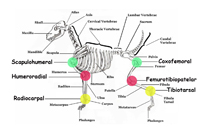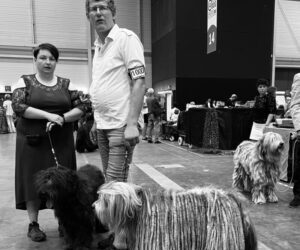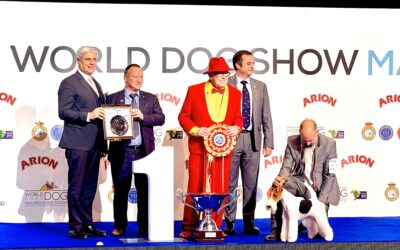There are concepts that even in the brains of people with as bad a memory as mine remain engraved and remain forever, this is the case of one that I found fascinating that I heard in a movement seminar that went like this: “The dog for his move study should be considered as a living machine which moves through the interaction of its bones, muscles, ligaments and tendons.”
I boast of having many books on dogs, about breeds, handling, breeding, judging and even movement, in many, if not almost all, there are illustrations of the dog’s skeleton with the names of each of its 320 bones, But none of the names of the joints are there, the importance of these joints lies in the fact that they have a direct influence on how the dog moves and also unlike the muscles, which can be optimized and, so to speak, ” modified” with exercise, diet, etc. Not the joints, these are preserved for life due to genetics.
Among the conversations between exhibitors and judges, there are very recurring phrases “That dog is very straight from the front” “That dog lacks angulation in the back” But they are always very inaccurate phrases that really tell us little.
Let’s start at the beginning, the branch of medicine that studies joints is called Arthrology, which during my veterinary career was studied during anatomy classes. I have to say, this subject I had an excellent teacher, a nice guy with a peculiar mustache who had with a good repertoire of jokes that he used to keep us awake since it was the 7 AM class. But as usual I’m already getting off topic, let’s get back to what matters to us. What is the definition of joint? Union of two rigid pieces that allow relative movement between them. In this case, the rigid parts are the bones, which move through the action of muscles, tendons and ligaments. There are several ways to classify joints, for now I do not think it is appropriate to delve into that topic, I will only mention that there are simple ones, which are those that are composed of only two bones and compound ones that involve three or more.
This article is very far from pretending to be a treatise on movement, so I will leave aside concepts such as point of balance, balance or harmony between angles, etc. Its purpose is simply to provide the reader with the names of the joints that have a direct influence on the way the dog moves, since there are some, if not many that do not.
The ones that do have it are the joints of the limbs and the way to name them is very simple, it is done by naming the upper bone that makes it up and adding the lower one. I will start with the forelimb, one of the most important is the Scapulohumeral, made up of the scapula and the humerus, which is responsible for the reach that the dog can have, that is, the amount of ground that the dog covers with each step, which will depend of its degree of angulation.
Next comes the Humeroradial, as its name suggests, made up of the humerus and the radius and we know it as the elbow, and the Radiocarpal, which is formed from the union of the radius with the carpus. Among other things, it depends on its correct structure that the dog can develop a movement typical of its breed in the front, the latter in most breeds is straight following the trajectory of the radius with its exceptions such as the Welsh Corgi Cardigan seen from the front and the Basenji seen in profile.
In the wear we first have the Coxofemoral formed by the hip, more specifically the acetabulum of the hip and the femur. This is what could be said to be the most important joint since being the strongest, the most robust is where the dog generates the driving force as such. The amount of ground that the dog covers with each step with the subsequent one depends on its degree of angulation. Next comes the Femurotibiopatellar, made up of the lower end of the femur, the patella and the tibia, also known as the knee, a good example of a compound joint, and finally, further down, the Tibiotarsal, which is made up of the lower end of the tibia and the tarsos, also It is known as hocks. Its importance lies in the fact that in all breeds its firmness has a direct influence on the efficiency in which the force that comes from the hip is used, its weak structure is what is known as a cow hocks.
Having said all this, I hope that the next time you have a conversation that involves the joints or the movement of the dog you can express yourself more precisely so that you optimize communication, remember that all our knowledge comes from communication.
“The best is yet to come”




